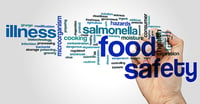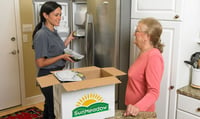When it comes to food preparation, one can never be too safe. As evidenced by Chipotle's norovirus outbreak, foodborne illness has the potential to harm consumers and devastate a business's bottom line. The manner in which food is handled during the preparation process plays a significant part in determining its on-the-plate integrity. Sure, some of the blame for foodborne illnesses can be cast upon food suppliers that fail to grow, cleanse, store and deliver ingredients in the proper manner. Yet the main onus of food safety is on those who actually handle the food immediately before it is served.
Common Food Safety Stumbling Blocks
Harmful bacteria can't be seen, tasted or smelled. This is precisely why food safety is such a daunting challenge. A food handler could prepare an absolutely gorgeous meal with diverse colors and tasty ingredients, serve it at the perfect temperature and unknowingly sicken diners. Even the slightest mistake in food preparation has the potential to result in mass illness.
In some instances, the ingredients are tainted with E. Coli or Salmonella from the get-go. In other instances, the food handler makes an error in the cold holding of temperature control for food safety. Some over-sanitize their food preparation space, unintentionally poisoning entree ingredients. Or, maybe food workers show up to their shift with unwashed hands or an illness and spread bacteria to a side dish/main course. A myriad of other food safety stumbling blocks regularly rear their ugly heads, from pest activity to cross-contamination and the use of expired ingredients.
The Four Main Steps of Food Safety
The Food Safe Families campaign has garnered significant attention for its food handling advice. The four steps of the campaign are as follows:
- Clean: Food handlers should always wash their hands before touching food. They should also wash their hands when returning from break and lunch. Furthermore, food preparation workers should thoroughly clean their hands after using the restroom. Merely running warm water over the fingers will not suffice. Rather, an extensive washing with hot water and anti-bacterial soap for at least 20 seconds is necessary.
- Separate: Food prep workers should be hyper-conscious of the possibility for cross-contamination. Cross-contamination can occur in a physical, chemical or biological manner. As an example, food handlers should take great care to avoid preparing something like a salad on a surface upon which raw meat was chopped.
- Cook: It is imperative that food handlers remain cognizant of the temperature at which each dish should be cooked. If meat, poultry and fish are not cooked at the proper temperature, the raw or under-cooked flesh could sicken diners. It is prudent to place cooking temperature “cheat sheets” in areas of the kitchen where meals are cooked.
- Chill: Food should not be left on the counter or other room-temperature areas to sit for extended periods of time. When in doubt, refrigerate food in a prompt manner. This way, there won't be an opportunity for bacteria to accumulate and possibly sicken those who consume the food at a later date.
Perishable food should be refrigerated within two hours, regardless of the circumstances. If the temperature is above 90 degrees Fahrenheit, perishable items should be refrigerated within the hour or less. Unfortunately, many restaurants, eateries and other food service providers fail to check the temperature of their refrigerator and freezer on a regular basis. Use an appliance thermometer to ensure that the refrigerator is at a maximum of 40 degrees Fahrenheit. The freezer should be kept at a maximum of zero degrees Fahrenheit. For more information on the steps to safe food, check out this blog article.
Food That Lacks an Expiration Date
If you were to poll food service workers regarding the expiration date for fresh food, you would receive an array of different answers. Most people think that fresh poultry, ground meats and fish can last for days. The truth is that these foods should be either cooked or frozen within two days after purchase. When it comes to veal, pork and lamb, the cook/freeze window stretches to a mere 3-5 days.
Freezing food is necessary to preserve its integrity beyond its initial freshness date. When in doubt, throw it out. Customer illness due to improper storage and general food worker negligence has the potential to harm the bottom line and even lead to crippling lawsuits.
Additional Food Preparation Tips
 Though most food service workers understand the importance of washing their hands, many forget to perform a thorough cleanse after handling food. It might seem a bit egregious to wash one's hands after handling each unique ingredient yet such a food safety tactic is vitally important to prevent the spread of bacteria and other harmful particles. Furthermore, the cutting boards, counter tops and utensils used to prepare food should be regularly sanitized with liquid chlorine bleach and water.
Though most food service workers understand the importance of washing their hands, many forget to perform a thorough cleanse after handling food. It might seem a bit egregious to wash one's hands after handling each unique ingredient yet such a food safety tactic is vitally important to prevent the spread of bacteria and other harmful particles. Furthermore, the cutting boards, counter tops and utensils used to prepare food should be regularly sanitized with liquid chlorine bleach and water.
GA Foods is creating a culture of food safety. Our goal is to become the industry gold standard in food safety and facility sanitation. We also want to help other dining sites and facilities excel in food safety practices. We have created FREE food safety training modules for your staff. Click below to download.











